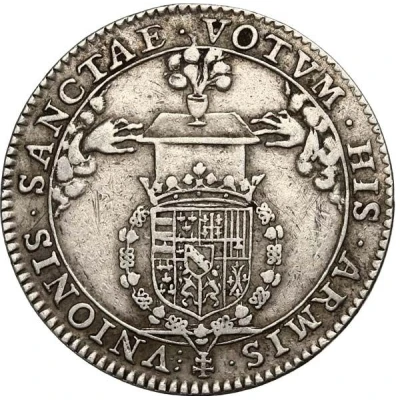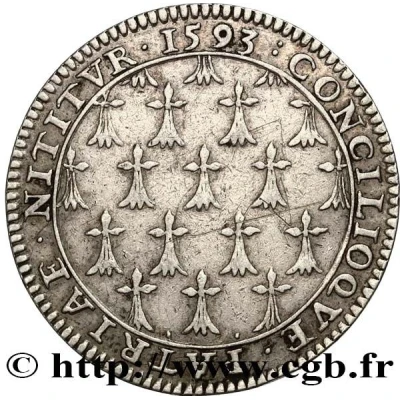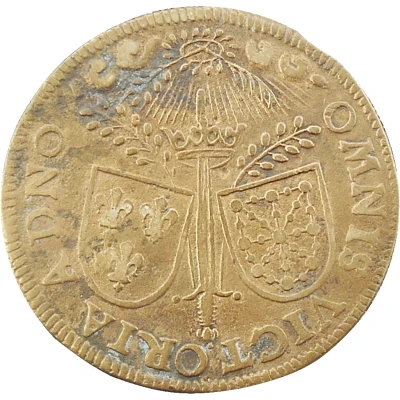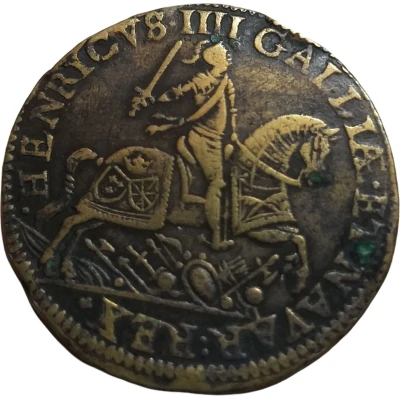
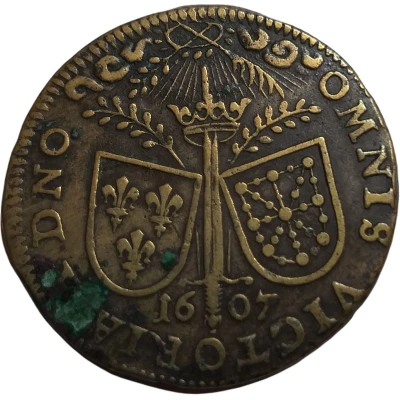

© milesteg11 (CC BY-SA)
Token - Henry IV - Omnis Victoria Adno date
| Brass | 4.77 g | 28.04 mm |
| Location | France |
|---|---|
| King | Henry IV (Henri IV) (1589-1610) |
| Type | Utility items › Counter tokens |
| Years | 1593-1607 |
| Composition | Brass |
| Weight | 4.77 g |
| Diameter | 28.04 mm |
| Thickness | 0.8 mm |
| Shape | Round |
| Orientation | Medal alignment ↑↑ |
| Demonetized | Yes |
| Updated | 2024-11-13 |
| Numista | N#85344 |
|---|---|
| Rarity index | 77% |
Reverse
Two round-based shields, of France and Navarre, flanking a drawn sword, point upwards, between two laurel or palm branches. The blade passes through an open crown and the point penetrates a heavenly chaplet set among clouds from which proceed rays and laurels. Lettering around, sword divides date. Toothed border
Script: Latin
Lettering:
OMNIS VICTORIA A DNO
1596
Translation: Every victory swim
Edge
Plain
Comment
NOTES: The lettering NAVA looks like it was overstamped on NAVR lettering. There is Feu. 11851 var (without date) also. A caparison is a cloth covering laid over a horse or other animal for protection and decoration.HENRY IV THE GREAT (02/08 / 1589-14 / 05/1610)
He became King after the tragic death of Henry III, Henry of Bourbon, King of Navarre, down from last son of St. Louis, Robert, Count of Clermont. With him begins the Bourbon dynasty that ruled France until the Revolution, died in the direct line in France with the Comte de Chambord, and still exists, in France, in her younger Orleans branch and outside France in his senior branch, with the houses of Spain, Parma and Sicily. By the statement of 4 August 1589, Henry IV promised the maintenance of the Catholic religion and the meeting of a national council. The time had yet to civil war. The Duke of Mayenne proclaimed king Cardinal de Bourbon, then a prisoner of Henry IV, under the name of Charles X. The King marched on Normandy and fought Mayenne near the castle of Arques (21 September 1589), but could not take Paris. A loyalist Parliament, chaired by Achille de Harlay, was installed in Tours. Having conquered the whole of Normandy, except Rouen, Henry laid siege to Dreux (February 1590). With the reinforcements of the Duke of Parma, Mayenne marched against him and met him at Ivry (March 1590). Once again, the Leaguers were defeated. The blockade of Paris, defended by the Duke of Mercoeur, began in May 1590. Mayenne and the Duke of Parma having appeared at the end of the summer, Henri surrounded the city with a loyal network of cities and bided his time. By the Edict of Mantes (July 1591), he restored the regime of the Edict of Poitiers. On the death of Charles X (1590), the Spaniards put forward the rights of the Infanta Isabella Claire-Eugenie, daughter of Philip II and Elizabeth of Valois. A Spanish garrison settled in Paris. The Duke of Savoy came in Provence, the Spanish in Languedoc. In December 1592, Mayenne summoned the States General in Paris. They opened in January 1593 and presented several demands: a Catholic king, periodicity States, restoration of provincial liberties, receipt of Trent in France, but refused the candidacy of Infante. A general truce was signed in July 1593; the same month, in Saint-Denis, Henri IV abjured Protestantism. The League soon began to disintegrate and the king was crowned at Chartres in February 1594. He entered Paris the following March. There was no form of repression. Picardy and the duke submitted themselves in turn, and Clement VIII gave absolution to Henry in September 1596. The war against Spain officially began in January 1595. Beaten at Fontaine-French (June 1595), the Spaniards had evacuate Burgundy and were pursued until Franche-Comté. Mayenne was submitted in October, Joyeuse and Epernon followed. In Britain, Mercœur continued a guerrilla war until 1598. The operations against the Spaniards were not favorable to the French in 1596 and 1597. The peace treaty was signed by the two monarchies exhausted in May 1598 the Treaty of Vervins returned the terms of the Treaty of Le Cateau. By the Edict of Nantes (April 1598), declared perpetual and irrevocable, freedom of conscience was granted to all Protestants; freedom of worship remained where it existed and was established in the Court. "Chambers of the edict," mid-parties were established to settle disputes between Catholics and Protestants. The party received hundred places of safety, including Montpellier, Montauban and La Rochelle. When peace returned, the situation of the kingdom was not less disastrous. Henry IV shows the biggest of statesmanship, forgetting the past, he surrounded himself with ardent Catholics, like Villeroy and President Jeannin, along with fervent Huguenots as Sully, Superintendent of Finance in 1601. cleverly, he gradually reduced the power of the governors and parliaments. In 1600, he married Marie de Medici, who gave him a dolphin in 1601. In 1602, he executed Marshal Biron, governor of Burgundy, who conspired to raise Catholics. In 1606, he marched against Sedan, capital of the Duke of Bouillon, who had fled the kingdom, and won the bid. The hostility persisted between France and the Habsburgs. In 1601, the Treaty of Lyon, the Duke of Savoy ceded to the King of France Bresse, Bugey, Gex and Valromey. In Italy, however, French influence remained zero. France supported the United Provinces under the table. On the side of the Empire, Henry was involved in the succession of Cleves and Jülich when he was assassinated by Ravaillac, May 14, 1610.
